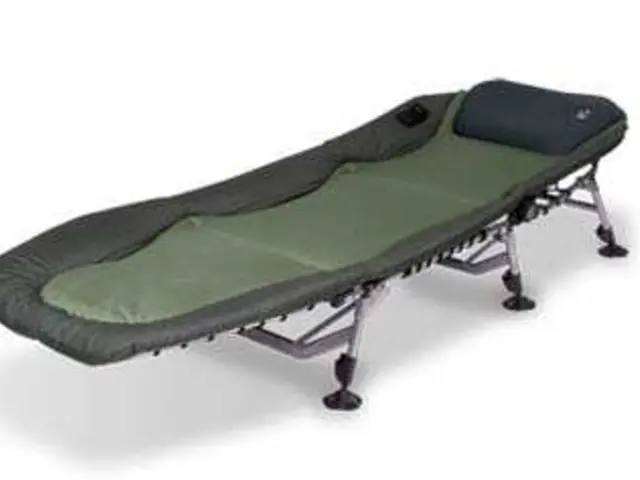Top 5 Tricks for Alleviating Discomfort from Runner's Knee (Patellofemoral Pain)
Feeling like your knees are crying out after an intense basketball game or a long day of desk work? Chances are, you might be dealing with patellofemoral pain syndrome (PFPS), also known as "jumper's knee" or "runner's knee." And guess what? You're not alone. As many as one out of four Americans suffer from knee pain, with at least a quarter of knee problems occurring where the kneecap and leg bones meet.
If your kneecap area is aching, don't panic. Exercise is the main treatment for PFPS. Factors like muscle imbalances, tight muscles, excessive load on the knees through faulty mechanics or overtraining, and even physical anatomy can contribute to patellofemoral pain.
To ease the discomfort, focus on strengthening and stretching exercises. Before you start, it's essential to warm up your muscles with five to seven minutes of light activity like stationary cycling or walking.
Now, let's talk about some effective exercises:
1. Clamshell
This move targets the gluteus medius muscle, which is vital for stabilizing the hips and knees. Lie on your side on a mat with your legs stacked and bent to 45 degrees. Keep your top leg bent and open it so your knee points to the ceiling. Hold for five seconds, then lower your leg to the starting position. Repeat 15 times before switching legs.
2. Wall squat
Wall squats are great for engaging your quadriceps, hamstrings, and glutes. Stand with your back against the wall and your feet about six to 12 inches away from the wall. Slowly slide your back down the wall until your legs are at a 45-degree angle. Hold this position for five to 10 seconds, then rise gradually to a standing position. Repeat 15 times multiple times a day.
When it comes to stretching, focus on the hips and legs daily to keep them flexible and reduce tension.
3. Standing hip flexor and quad stretch
This stretch helps prevent hip flexor and quad tightness linked to knee pain. Stand upright with one leg bent and resting on a stable chair behind you. Gradually shift your weight forward at your hips, squeezing your glutes, and hold the stretch for 15 to 30 seconds. Perform five repetitions with the same leg before switching to the opposite leg.
4. Single-leg Romanian deadlift
This exercise actively stretches your hamstrings, the thigh muscles that help bend your knees. Stand with your feet shoulder-width apart and shift your weight to your left leg while slightly bending your left knee. Bend forward from your hip while reaching your right arm toward the floor as your right leg lifts off the floor and back. Hold for five to 10 seconds and return to the starting position. Repeat 10 to 15 times with the same leg before switching to the opposite leg.
5. Calf stretches on stairs
These stretches focus on your calf muscles, which are responsible for propelling you when you walk, run, or jump. Stand with the balls of your feet on the edge of a step. Slowly lower your heel toward the floor while slightly bending your opposite leg. Hold the stretch for five to 10 seconds and switch sides.
If you're looking for some low-impact aerobic activities to help maintain your cardiovascular fitness during recovery, try using an elliptical machine, swimming, water aerobics, outdoor or stationary cycling, rowing machine, upper-body ergometers, or walking outside on a flat surface or on a treadmill.
When it comes to activities to avoid, steer clear of high-impact exercises like running, high-impact aerobics, lunges, and deep squats, as well as sports like basketball, volleyball, and jumping rope that put a lot of force on your knees.
In conclusion, exercises are crucial in the battle against PFPS. By strengthening key muscles and improving flexibility, you can help reduce knee pain, manage pain levels, and lower the risk of future episodes. So lace up, stretch out, and get ready to feel the burn – all in the name of pain-free knees!
- Health-and-wellness activities like the clamshell exercise, wall squats, standing hip flexor and quad stretch, single-leg Romanian deadlift, and calf stretches on stairs can help ease patellofemoral pain syndrome (PFPS) by strengthening and stretching crucial muscles and reducing tension.
- To complement exercise, focusing on proper nutrition for food and maintaining a well-balanced diet is essential in ensuring overall health and wellness, which can contribute to a faster recovery from PFPS.
- Science and sports analysis can provide valuable insights into the causes and treatments of PFPS, helping athletes and individuals understand the mechanics involved in knee pain and how to prevent it.
- Fitness-and-exercise regimens should include low-impact aerobic activities, such as using an elliptical machine, swimming, water aerobics, outdoor or stationary cycling, rowing machine, upper-body ergometers, or walking outside on a flat surface or on a treadmill, to maintain cardiovascular fitness during recovery and minimize knee pain.








